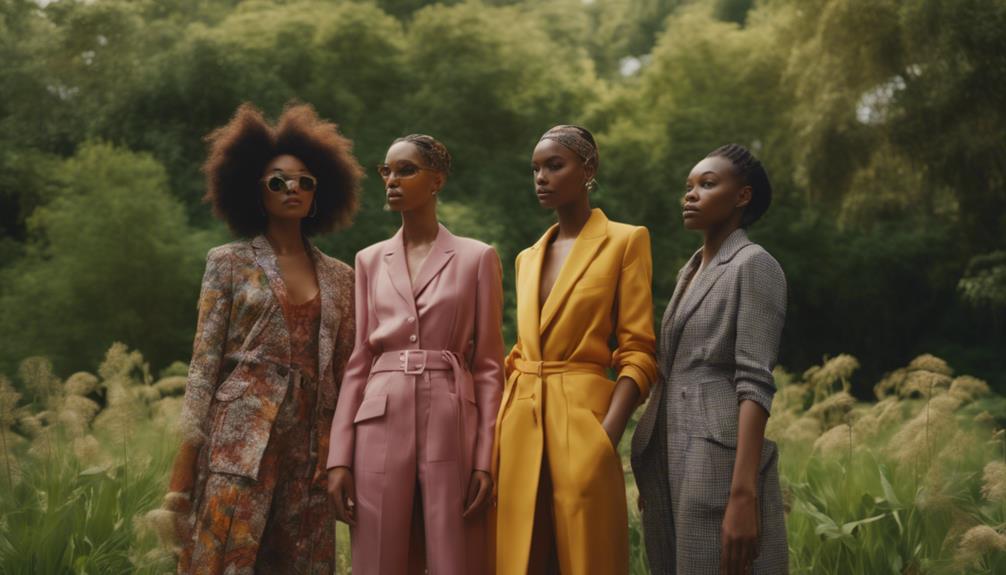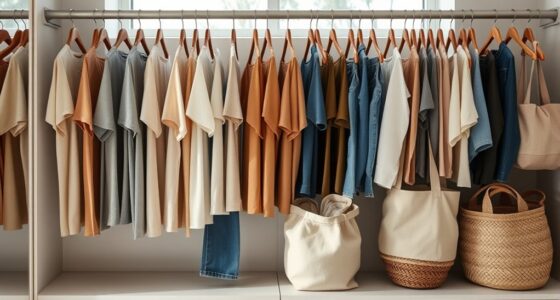In 2023, you will find that there are more than 1,000 brands recognized as sustainable fashion companies! This number is truly astonishing and shows a growing consumer demand for ethical clothing. As people become more conscious of environmental and social issues, brands are rising to meet these demands. You will come across a mix of popular names and emerging labels dedicated to sustainability. The increase in secondhand shopping and use of innovative materials is also contributing to this trend. Interested in how this movement is impacting the industry and what it indicates for the future? There is a lot more to uncover!
Key Takeaways
- In 2023, over 1,000 brands are recognized as sustainable fashion companies globally.
- The sustainable fashion market is projected to reach $10.1 billion by 2025, reflecting significant growth.
- 72% of US consumers show interest in purchasing sustainable clothing, indicating rising demand.
- The ethical fashion market is growing at an annual rate of 8.3%.
Current Number of Brands
As of 2023, you'll find over 1,000 brands recognized as sustainable fashion companies, covering everything from clothing to accessories. This impressive number reflects a significant shift in the fashion industry towards sustainable practices. These brands emphasize transparency and ethical practices, ensuring that their operations align with responsible sourcing and production methods.
The sustainable fashion market is rapidly expanding, with projections indicating a market value of $10.1 billion by 2025. This growth is largely driven by US consumers, with around 72% expressing interest in purchasing sustainable clothing.
This growing demand isn't only for new sustainable products but also for secondhand and thrift shopping options. In fact, the secondhand market is growing three times faster than overall fashion sales, showcasing a shift in consumer behavior toward more eco-friendly choices.
Emerging brands are tapping into this trend, not just by promoting their sustainable practices but also by encouraging a culture of conscious consumerism. As you explore these sustainable fashion brands, you'll see a diverse range of options that cater to your values while making a positive impact on the environment.
Factors Affecting Brand Count

Several factors are driving the increase in the number of sustainable fashion brands, reflecting shifts in consumer demand and industry practices. The ethical fashion market is growing at an impressive rate of 8.3% annually, indicating that more consumers are seeking sustainable options. This rising consumer demand encourages new brands to enter the market, contributing greatly to the overall count.
However, transparency issues complicate the landscape; only about 12% of brands disclose their annual production volumes, making it tough to gauge the exact number of sustainable fashion labels. Additionally, the complexity of supply chains and the prevalence of greenwashing create confusion, leaving many consumers unsure of which brands genuinely prioritize sustainability.
On the positive side, innovations in sustainable materials and the shift toward circular fashion models are paving the way for new entrants in the sector. As brands adopt environmentally friendly practices, the sustainable fashion landscape continues to evolve, making it more challenging yet exciting to track the growth.
Geographic Distribution of Brands

The geographic distribution of sustainable fashion brands reveals a dynamic landscape influenced by varying levels of consumer demand and regulatory support across different regions.
In North America, you'll notice a growing appetite for sustainable fashion, with consumers increasingly favoring brands that prioritize ethical practices within the fashion industry. Meanwhile, Europe stands out as a leader, home to numerous innovative brands that champion environmental responsibility.
The Asia Pacific region holds a substantial 36% of the global ethical fashion market, showcasing a significant presence of sustainable brands that cater to a diverse audience. This growth is buoyed by increasing consumer demand for eco-friendly options and the emergence of local sustainable brands that resonate with cultural values and environmental concerns.
Emerging markets are also making their mark, as they witness a rise in local sustainable fashion initiatives. Countries like France are implementing regulations promoting sustainability, further shaping the geographic distribution of ethical fashion brands.
As these regions continue to evolve, the accessibility and diversity of sustainable options will expand, allowing you to make more conscious choices in your wardrobe.
Consumer Perception of Brands

When it comes to sustainable fashion, your trust in a brand's sustainability claims can greatly shape your purchasing decisions.
You might also find that your awareness of ethical brands is influenced by social media and fashion media coverage.
Understanding these factors can help you navigate an increasingly eco-conscious marketplace.
Trust in Sustainability Claims
Trust in sustainability claims has become an essential factor for consumers steering through the fashion industry, as many are wary of misleading information and greenwashing. With 72% of US consumers aware of sustainability issues, it's clear that you care about making ethical choices.
However, almost half of you are unsure where to find reliable sustainable brands. This uncertainty stems from concerns about misleading claims, particularly when only 12% of fashion companies disclose their annual product volumes.
Transparency plays a vital role in fostering trust. When brands openly share their production processes and sourcing practices, they build a sense of loyalty among consumers like you.
Unfortunately, about 93% of surveyed brands fail to pay garment workers a living wage, raising serious ethical questions about their sustainability claims. This lack of accountability makes it difficult to discern which brands genuinely prioritize ethical practices.
As you navigate the fashion landscape, look for brands that demonstrate transparency and commit to fair treatment of workers. By doing so, you can make informed choices that align with your values and support truly sustainable fashion.
Awareness of Ethical Brands
Consumer awareness of ethical brands is on the rise, with 72% of US shoppers acknowledging sustainability issues in the fashion industry. This shift indicates a growing demand for sustainable fashion and ethical brands.
However, there's a challenge: 48% of consumers are unsure where to find these sustainable options, highlighting a gap in accessibility and information.
Millennials are leading the charge, with many willing to pay more for ethical consumption. They've adjusted their shopping habits to prioritize sustainability, often actively seeking brands that align with their values. A study shows that 69% of Vogue readers also prioritize sustainability, reinforcing that ethical considerations are essential for fashion-conscious consumers.
Moreover, market trends reveal that 73% of British buyers who choose sustainable clothing also purchase second-hand clothing, reflecting a broader acceptance of ethical consumption practices.
As you navigate the fashion landscape, remember that while awareness is rising, the journey toward finding accessible ethical brands continues. You're not alone in this quest; together, we can push for more transparency and availability in sustainable fashion.
Impact of Social Media
Social media has reshaped how you perceive fashion brands, often blurring the lines between sustainable choices and fast fashion trends. Platforms like TikTok have contributed to a culture of excessive consumption, with #haul videos amassing over 49 billion views. This environment makes it tough to discern which brands actually prioritize sustainability.
| Influence | Impact |
|---|---|
| Social Media Influencers | Promote fast fashion, driving trends |
| Consumer Awareness | 72% of consumers know sustainability issues, yet fast fashion dominates |
| Brand Practices | Many brands prioritize low-cost items over sustainable options |
About 54% of consumers link the rise of fast fashion to influencers. Although 69% of Vogue readers value sustainability, social media's fast-paced narrative encourages frequent purchases and stigmatizes outfit repeating. This alters your perception of clothing lifespan and value, presenting challenges for sustainable fashion brands working to gain your attention. With these factors at play, steering consumer behavior towards sustainable choices becomes increasingly complex.
Challenges for New Brands
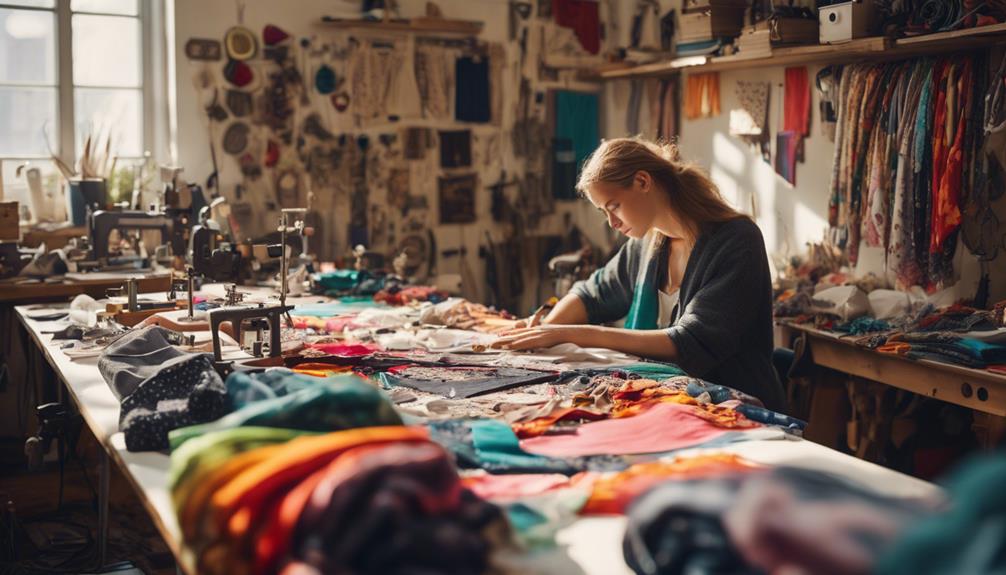
Charting the sustainable fashion landscape poses significant challenges for new brands enthusiastic to make their mark. With the industry valued at over $6.5 billion, increasing market competition means you'll need to stand out.
One major hurdle is transparency; only 12% of fashion companies disclose annual product volumes, making it tough for consumers to evaluate your impact. You also face substantial barriers to entry, such as high production costs tied to sustainable materials, which can hinder your ability to compete with fast fashion giants.
Steering through the complexities of supply chains is another challenge; ensuring reliable sourcing and ethical manufacturing practices demands significant investment in research and development. Moreover, consumer awareness around greenwashing is on the rise. Many shoppers are cautious of misleading sustainability claims, so you'll need to prioritize authenticity in your messaging.
Building trust through transparent practices is vital. By addressing these challenges head-on, you can carve out your niche in the sustainable fashion sector, gaining the consumer loyalty essential for growth and longevity. Embrace these obstacles as opportunities to show your commitment to genuine sustainability.
Notable Sustainable Brands
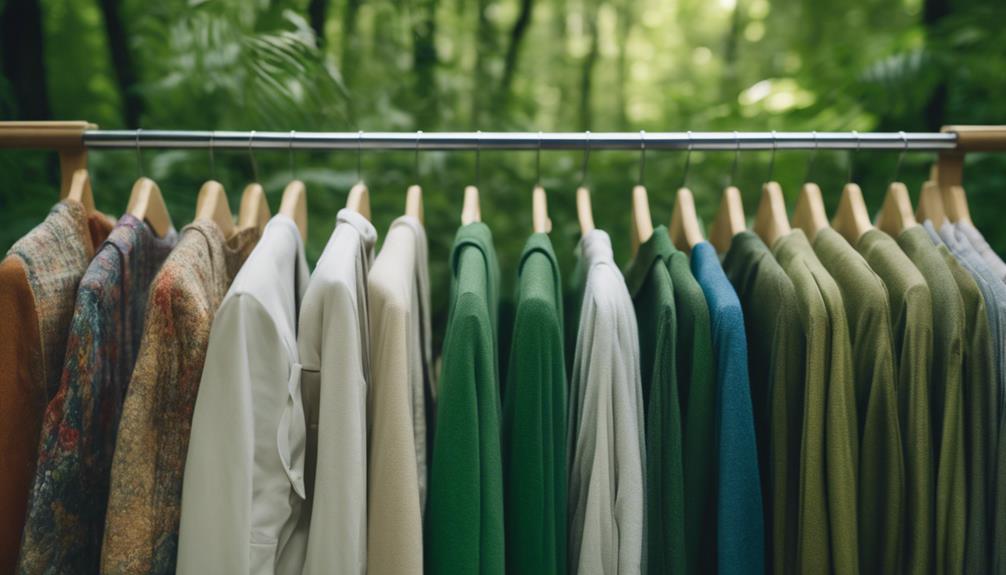
Several notable sustainable fashion brands are leading the charge towards a more eco-friendly future, each bringing unique practices and innovations to the industry.
Patagonia is a standout, known for its durable outdoor wear and commitment to environmental activism. Eileen Fisher emphasizes organic materials and fair labor practices, showcasing how sustainable fashion can also prioritize people.
Reformation takes transparency to the next level by providing detailed information about their eco-friendly clothing sourcing and production processes, building trust with consumers. Meanwhile, Stella McCartney pioneers luxury sustainable fashion, using innovative materials like vegan leather and promoting ethical supply chains.
The rise of secondhand platforms like ThredUp and rental platforms such as Rent the Runway highlights changing consumer habits. More people are turning to these options to reduce their environmental impact and combat the wastefulness of fast fashion.
Impact of Fast Fashion
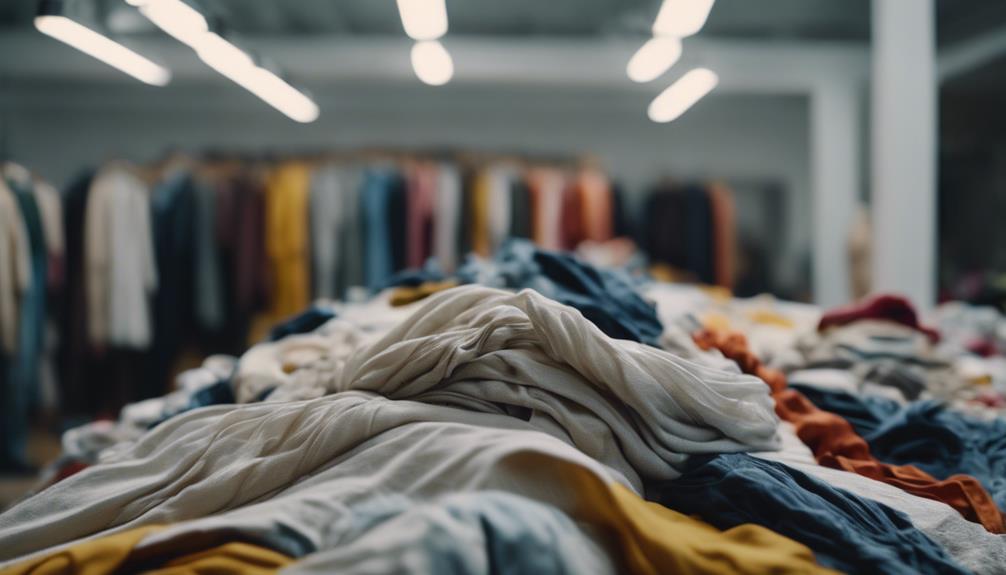
Fast fashion's impact on the environment is staggering, with the industry generating an estimated 92 million tonnes of textile waste every year and contributing greatly to climate change. You mightn't realize it, but fast fashion accounts for 2-8% of global greenhouse gas emissions. This alarming statistic highlights how your clothing choices contribute to climate change.
On average, clothing items are worn only 7-10 times before being discarded, reflecting unsustainable consumption patterns. The textile industry promotes a cycle of overconsumption and throwaway culture that leads to massive clothing waste. Additionally, the production of fast fashion contributes to significant pollution, with the industry responsible for 20% of global wastewater.
Fast fashion relies heavily on synthetic fibers, which make up about 64% of global fiber production. These materials not only increase ocean pollution but also lead to environmental degradation.
As you consider your wardrobe, it's crucial to recognize the broader impacts of fast fashion. By choosing sustainable fashion, you can help mitigate these issues and support a more responsible approach to clothing that prioritizes the planet.
Future of Sustainable Brands
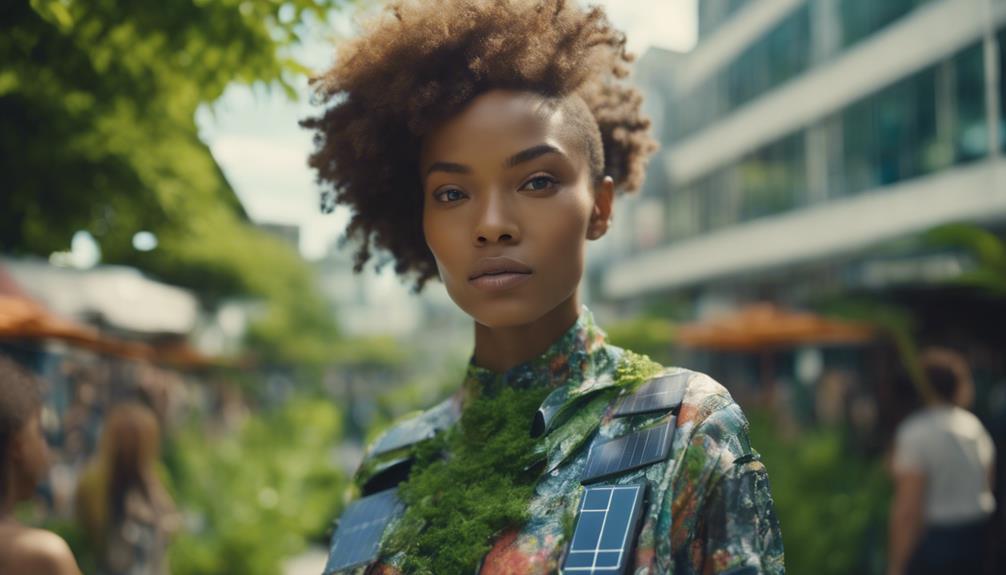
As you look ahead, the future of sustainable brands is bright with emerging innovations that could reshape the industry.
You're likely to notice a surge in consumer demand for ethical practices, pushing both new and traditional brands to adopt eco-friendly approaches.
This shift not only enhances your fashion choices but also promotes a more sustainable market.
Emerging Brand Innovations
Emerging fashion brands are revolutionizing the industry with innovative materials and practices that prioritize sustainability. They're utilizing sustainable materials like mushroom-based leather and plant-based nylon, driving eco-friendly production methods that appeal to conscious consumers. Many of these brands embrace a circular fashion model, focusing on recycling and upcycling to promote waste reduction and extend garment life cycles.
Tech-savvy solutions, such as blockchain, are enhancing transparency in supply chains, allowing you to verify ethical sourcing with ease. This transparency builds trust and empowers you to make informed consumer choices. Additionally, emerging brands are increasingly opting for local production, greatly reducing carbon footprints while supporting regional economies.
Digital platforms and apps are also playing an essential role in this movement, making it easier for you to discover and engage with sustainable fashion brands. By choosing these innovative options, you're not just making a purchase; you're contributing to a more sustainable future.
As these brands continue to grow and innovate, the fashion industry is set to transform, putting ethics and sustainability at the forefront of consumer preferences.
Consumer Demand Trends
Consumer demand for sustainable fashion is skyrocketing, with a projected market growth from over $6.5 billion to $10.1 billion by 2025. This surge reflects a significant shift in consumer priorities, especially among Millennials and Gen Z, who lead the charge for eco-friendly clothing and ethical purchasing.
| Consumer Group | Interest in Sustainable Fashion | Preference for Second-Hand Clothing |
|---|---|---|
| Millennials | 80% willing to pay more | 70% |
| Gen Z | 75% prefer pre-owned clothing | 73% |
| Total Consumers | 73% buy second-hand | 68% |
| Eco-friendly Segment Growth | $1.57 billion increase | N/A |
A whopping 80% of young adults in the U.S. are ready to invest more in sustainable brands, showing that clothing waste is no longer acceptable. The eco-friendly clothing segment is expected to grow by $1.57 billion, driven by increasing awareness and desire for sustainability. As consumers increasingly engage in ethical purchasing, the trend towards second-hand clothing will only continue to strengthen, reshaping the future of the fashion industry.
Importance of Transparency
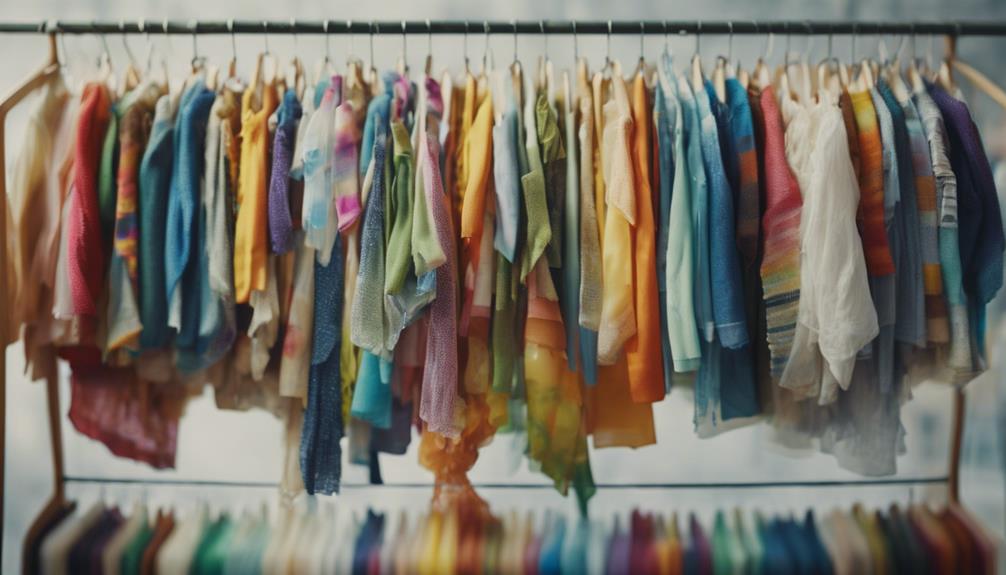
Transparency in the fashion industry isn't just a nice-to-have; it's essential for holding brands accountable and fostering sustainable practices. Right now, only 12% of fashion companies disclose their annual product volumes, leaving a staggering 88% shrouded in opacity. This lack of transparency contributes considerably to the overproduction crisis we face today. Fast fashion brands, like SHEIN, are notorious for cranking out over 300,000 new styles each year—this alarming rate underscores the urgent need for accountability in their production practices.
Transparency isn't just about numbers; it's imperative for addressing human rights violations and environmental degradation in fashion. When brands commit to openly sharing their production processes, they empower consumers to make informed choices. You deserve to know where your clothes come from and how they're made. High standards and trustworthy assurance systems are essential for promoting sustainable practices, as sustainability can't thrive without that commitment to transparency in sourcing and production.
In short, when you advocate for transparency, you're not just supporting brands; you're pushing the entire fashion industry toward a more sustainable and responsible future.
Frequently Asked Questions
What Percentage of Fashion Brands Are Sustainable?
You'll find that only about 12% of fashion brands meet sustainability standards. Most companies still prioritize profit over ethical practices, leaving a small percentage genuinely committed to making sustainable choices for the environment and society.
What Are the Statistics for Sustainable Brands?
You'll find that the sustainable fashion market is booming, valued at over $6.5 billion, with projections reaching $15 billion by 2030. About 30% of European consumers actively seek sustainable brands, reflecting increasing market demand.
Are 72% of Consumers Aware of Sustainable Fashion Concerns and Are Making Decisions Based on a Company's Environmental Impact
With 72% of consumers aware of sustainability issues in fashion, you're likely influenced by environmental impacts when shopping. This awareness signals a shift toward ethical choices, yet many still struggle to find sustainable options.
Conclusion
As the tide of sustainable fashion rises, you might find the number of brands both surprising and heartwarming. Each label represents a small beacon of hope, endeavoring to weave a brighter future for our planet.
While challenges loom like dark clouds, the collective effort of these brands shines through, illuminating the path forward.
Embracing transparency and mindful consumption, you're joining a movement that transforms the landscape of fashion, one thoughtfully crafted piece at a time.

